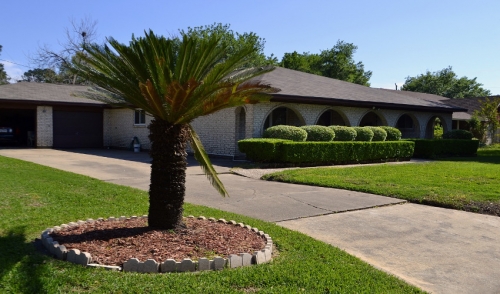
Mulching in the South
Mulch is more than just an attractive finishing touch on your flowerbeds and around your plantings, it also performs several vital functions to keep your landscape lush and healthy. In the South, especially, mulch can add a great deal to your landscape, but if done improperly, it can also be damaging.
What Mulch Does for Your Landscape
Mulch serves many purposes in the landscape, all of which can help your plants reach their full potential for vibrant growth, beautiful blooms and productive harvests. Properly applied, mulch will…
- Insulate soil from the extremes of hot or cold temperatures
- Retain water in the soil and minimize moisture lost to evaporation
- Minimize weed growth by inhibiting weed seed germination
- Reduce mower and trimmer damage by providing a buffer zone around plants
- Control pests and unwanted insects, depending on mulch types
- Adjust soil pH to better accommodate acid-loving plants
- Encourage beneficial earthworms in the soil around plants
- Gradually feed plants as it decomposes into essential nutrients
- Serve as groundcover in difficult areas, such as heavy shade
- Reduce soil erosion in runoff areas or climates with heavy rains
Not all types of mulch will serve every purpose, and how well mulch performs will depend on how it is applied, what plants it is protecting and how the mulch is maintained. With so many benefits to the proper use of mulch, however, it is always best to understand how to use it well so your landscape will prosper.
Mulching Tips for Southern Landscaping
Southern landscaping is subject to different stresses than landscapes in northern climates. While mulching is still a critical part of a healthy, attractive yard and garden in all parts of the south, it needs to be handled carefully to show off its southern charm.
- Organic mulches are best in southern landscaping to add richness to the yard and to nourish landscapes that grow actively for much of the year. Avoid mulches made from rubber or dyed mulches that could leach chemicals into the landscape. Dyed mulches will also fade much more quickly in stronger southern sunlight.
- In areas where drainage is difficult because of intense southern rains, inorganic rock mulches may be preferred. Different colors and styles of rock mulches are available, but be sure to choose varieties that coordinate well with plantings as well as sizes of rocks that are suitable for the terrain.
- Because organic mulches will decay more quickly in southern heat and humidity, it is best to mulch in both spring and fall to keep the mulch layer appropriately thick and in good condition. Inorganic mulches such as rock will not decay, but will need to be maintained to remove debris so they still look their best.
- Opt for mulches made from native materials for the best appearance. Mulches from cypress and pine materials do best in the south and blend more seamlessly with southern landscaping. Because they can be locally sourced, these mulches can also be less expensive.
- A mulch layer of 2-3 inches deep is best for southern landscaping. This is deep enough to enjoy the benefits of mulch without smothering roots or blocking rains that are essential to keep semi-tropical or tropical plantings lush and green.
- Do not pile mulch deeply around the base of plants or insects and fungus may use the mulch as a way to more easily invade the plant and damage its stem, trunk or foliage. Instead, keep mulch at least 1-2 inches away from the base of plants.
- Because termites are more prevalent in the south, organic mulches should not be layered directly against the base of a house or other structure. Keep mulch at least 12 inches from the house to minimize the risk of termite invasions even when termite treatments have been applied, and use inorganic mulches directly against walls instead.
- Extend a mulch layer out to the drip line of plants to provide the best protection. The youngest, most active roots are out at a plant's drip line, and they take up the majority of moisture and nutrition a plant needs. Mulching at that point will do the most good to help plants thrive.
- Because southern mulch will be visible and useful year-round, it needs refreshing every few weeks. Raking and turning the mulch will keep its color at its best, and will help prevent compaction that could stifle the plants it means to protect.
Mulch is an essential part of a well-designed landscape, and it can be just as useful in flowerbeds and around trees as it is under shrubbery or in the garden. By understanding the unique needs of mulching in the South, you can be sure your southern landscape takes advantage of every benefit mulch provides.


